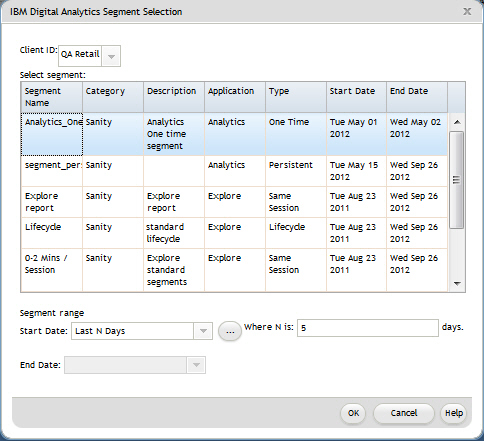
|
1.
|
Double-click a Select process in a Campaign flowchart to open the Select Process Configuration dialog.
|
|
2.
|
|
3.
|
|
|
Select a Client ID from the list to display a list of all published segments associated with that IBM® Digital Analytics client.
|
|
|
The Select segment list shows the segments defined in IBM® Digital Analytics, including the Application where the segment was created, its Type, and its Start and End Dates.
|
|
|
The Description should help you determine the purpose of the segment. If you need more information about a segment, double-click it to see the segment expression and other information defined in IBM® Digital Analytics.
|
|
|
The Start Date and End Date next to each segment indicate the IBM® Digital Analytics-defined date range for finding visitors who match the segment criteria. For example, one segment might find everyone who visited a particular site at least 3 times between January 12, 2012 and April 12, 2012, and another segment might find visitors from a different range of dates. The IBM® Digital Analytics-defined date range cannot be changed here. However, you can use the Segment range date controls at the bottom of the dialog to define a date range that falls within the range defined in IBM® Digital Analytics.
|
|
5.
|
Use the Segment range date and calendar controls at the bottom of the dialog to specify the date range from which you want to obtain data for the selected segment.
|
|
|
The range that you specify must fall within the Start Date and End Date defined for the segment in IBM® Digital Analytics (shown next to each segment in the list).
|
|
|
In addition to taking the Start and End Date into account, Campaign also considers the date constraint (if any). The date constraint is defined in IBM® Digital Analytics but does not appear in the Segment Selection dialog. The date constraint limits the number of days' worth of data to pull for a segment, to ensure that IBM® Digital Analytics is not overloaded with exporting a large data set.
|
|
|
You can specify absolute or relative dates, as long as they fall within the IBM® Digital Analytics-defined range and date constraint.
|
|
|
If you specify an absolute Start Date, you must also supply an End Date. For example, if the IBM® Digital Analytics-defined segment defines a 3-month span, your campaign can target visitors whose information was gathered on a single day, month, or week within that span.
|
|
|
If the IBM® Digital Analytics-defined segment is for a 3-month span, you can specify a relative date, such as Yesterday or Last 7 Days, to continually find recent visitors. The campaign will run successfully until the IBM® Digital Analytics-defined End Date occurs.
|
|
|
If you specify THIS MONTH, the full month of data must be available up until the day before this relative date is used. For example, if today is March 28, data from March 1 - March 27 must be available for the selected segment.
|
|
|
If you specify LAST MONTH; the full previous month of data must be available. Example #1: If the IBM® Digital Analytics-defined segment has a start date of March 1 and an end date of March 31, LAST MONTH can be used starting on April 1, up to and including April 30 (to get data for the month of March). Example #2: If the IBM® Digital Analytics-defined segment has a start date of March 1 and an end date of March 30, LAST MONTH cannot be used, because there is not a full month of data. Example #3: If the IBM® Digital Analytics-defined segment has a start date of March 2 and an end date of March 31, LAST MONTH cannot be used, because there is not a full month of data. In these cases, a message indicates that LAST MONTH does not fall within the segment dates. Instead, you must use absolute dates.
|
|
6.
|
|
Copyright IBM Corporation 2015. All Rights Reserved.
|